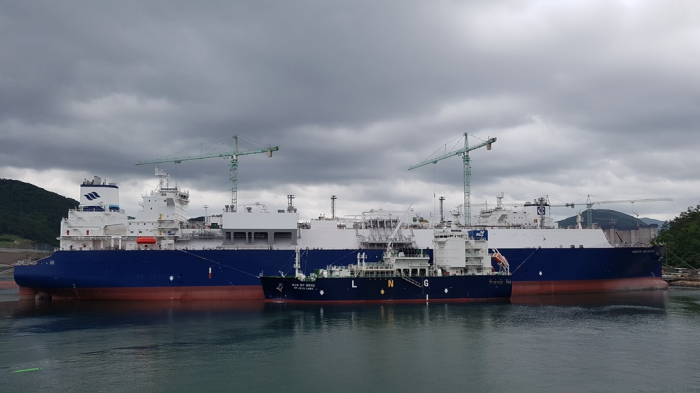Energy
KOGAS attempts to expand LNG bunkering as global demand grows
Korea LNG Bunkering’s carrier completed the world’s first STS test in November 2020
By Jul 26, 2021 (Gmt+09:00)
1
Min read
Most Read
LG Chem to sell water filter business to Glenwood PE for $692 million


KT&G eyes overseas M&A after rejecting activist fund's offer


Kyobo Life poised to buy Japan’s SBI Group-owned savings bank


StockX in merger talks with Naver’s online reseller Kream


Meritz backs half of ex-manager’s $210 mn hedge fund



Korea Gas Corp. (KOGAS) aims to expand liquefied natural gas (LNG) bunkering business as global demand for cleaner fuels for ships is growing.
LNG bunkering is the practice of fueling a ship with the gas, cleaner than conventional fuels such as diesel. LNG reduces sulfur oxide (SOx) and dust by 100%, as well as fine dust by 99% compared to those fuels. The gas also cuts emissions of nitrogen oxide (NOx) and carbon dioxide by 15-80% and 20%, respectively.
LNG bunkering demand is expected to reach 20 million-30 million tons by 2030. Global energy majors Shell and Total forecast LNG bunkering will account for 20-30% of the global ship fuel markets until then.
KOGAS completed a registration of Korea LNG Bunkering, a subsidiary for LNG imports, storage, shipments and supplies, in December last year for the business. The wholly owned subsidiary of KOGAS is in talks for cooperation between the government and private sectors.
For the business, it is essential to secure LNG storage tanks, bunkering ships and loading facilities. Korea LNG Bunkering plans to rent and use KOGAS LNG equipment including four loading facilities at the Tongyeong LNG terminal in South Gyeongsang Province.
Korea LNG Bunkering operates an LNG carrier SM Jeju LNG2, which KOGAS said completed the world’s first ship-to-ship (STS) LNG bunkering test in November 2020. In May this year, it loaded the gas to an LNG carrier using the STS method at Samsung Heavy Industries’ shipyard in the Geoje Island, South Gyeongsang. It ordered a tanker only for bunkering in February, which will be operated from early 2023.
Korea LNG Bunkering aims to sell 1.36 million tons of LNG with a revenue of 1 trillion won ($865.8 million) by 2030. That will reduce 8,315 tons of SOx and 2,557 tons of fine dust. It is set to expand the business to cover the whole country by securing five more bunkering ships and one loading facility.
Write to So-Hyeon Kim at alpha@hankyung.com
Jongwoo Cheon edited this article.
More to Read
-

-
 Korean chipmakersSamsung in talks to supply customized HBM4 to Nvidia, Broadcom, Google
Korean chipmakersSamsung in talks to supply customized HBM4 to Nvidia, Broadcom, Google16 HOURS AGO
-
 EnergyLS Cable breaks ground on $681 mn underwater cable plant in Chesapeake
EnergyLS Cable breaks ground on $681 mn underwater cable plant in ChesapeakeApr 29, 2025 (Gmt+09:00)
-
 Business & PoliticsUS tariffs add risk premium to dollar assets: Maurice Obstfeld
Business & PoliticsUS tariffs add risk premium to dollar assets: Maurice ObstfeldApr 29, 2025 (Gmt+09:00)
-

Comment 0
LOG IN


